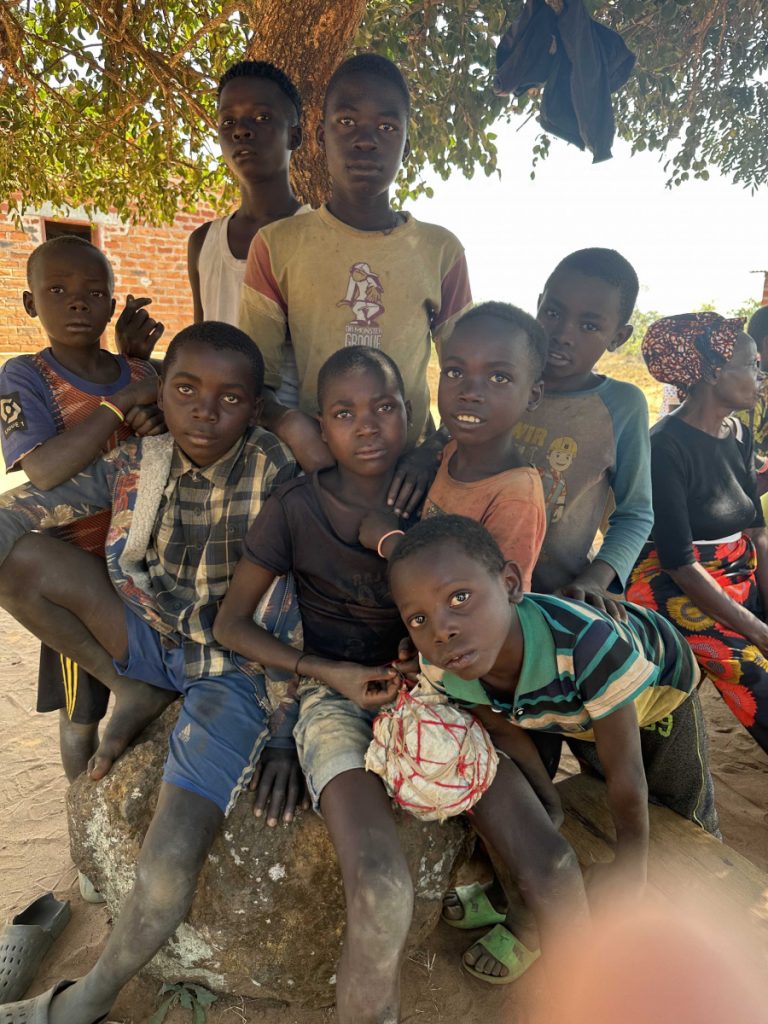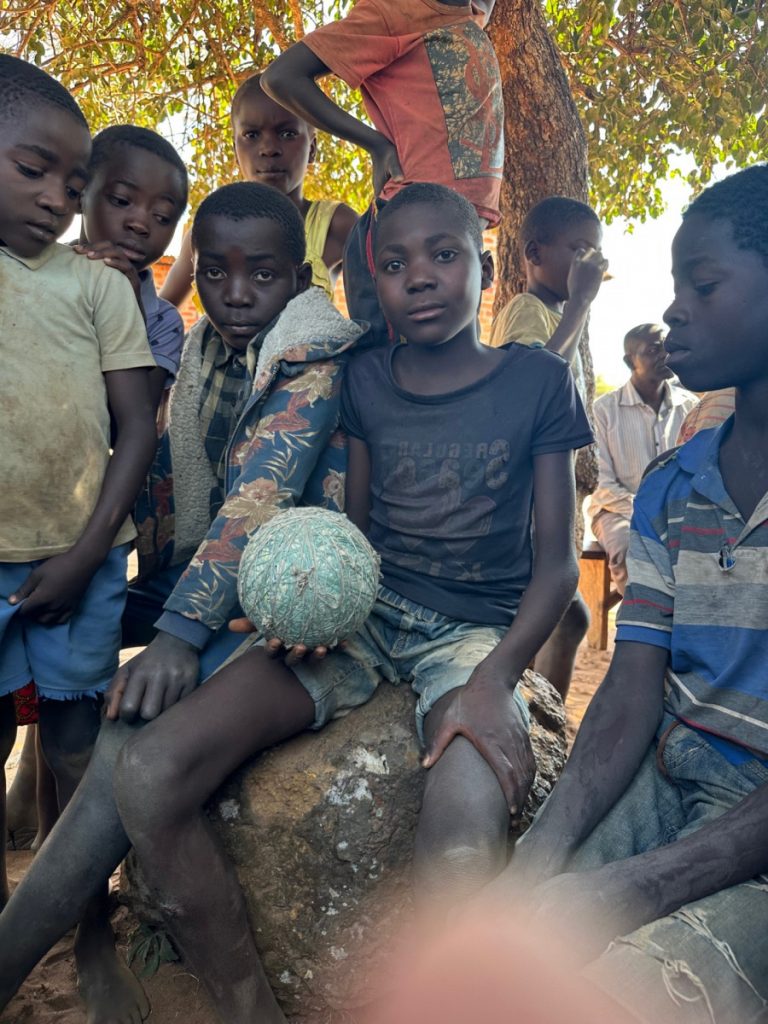
About 20 minutes into a rigorous game of dodge ball in the small town of Dipalata, about an hour’s drive from Zambezi, a young man grabbed the homemade ball only to find that it had deflated. His next hand motion was matter-of-fact: squeezing to ensure he expelled the ball’s last breath.
We asked one of our adult hosts, Pepytex—the Saint Clera Catholic Church choir director—if he could explain how the ball was made. “It’s a balloon.”
The ball was handed to another boy, Chiteta, who began meticulously disassembling it. He slowly unwrapped yards of red yarn, gray embroidery thread, and some nondescript string, all tied together to bind layers of cloth scraps, plastic shopping bags, and well-worn paper “trash.”
Chiteta and his mate carefully salvaged each component, rolling the yarn, stacking the bags, and setting aside the cloth and paper. The process took at least 10 minutes.
We asked where they might find a new balloon to remake the ball, and Pepytex said from the nearby missionaries who operate a 24/7 maternity clinic. A few minutes later a new “balloon” appeared. One of Chiteta’s friends began blowing it up, and we quickly realized the centerpiece of these homemade balls is a condom, surely intended to prevent the spread of some STD or other. After Chiteta’s friend, probably nine or ten years old, deftly pushed the end of the condom back in on itself to create a double layer, he blew it up just as our children at home might inflate a latex balloon at a birthday party. It’s clear to us that for all the good medical missionaries might be doing to enhance health outcomes in places like this corner of Zambia, they are (intentionally or not) also enhancing the recreational lives of the local youth.
Chiteta then began the careful process of putting all the pieces back together. He wrapped a piece of the worn paper, almost transparent from overuse, around the balloon, followed by sections torn from plastic sacks and then cloth. Holding the pieces tightly together—sometimes aided by a friend—Chiteta began to wrap lengths of yarn around the emerging ball as we watched his work take shape. With the string snugly bound, he began a second and then third layer, all in the same order. In total, he wrapped the ball five times before his task was complete. Each layer of paper, plastic, and cloth was tightened with a new web of string and yarn. The ball grew larger, the wrapping of the string requiring increasing force with each layer, and the exertion was evident. Occasionally, Chiteta would pass the work to a friend, who’d take an exhausting turn wrapping yarn before handing it back. The final web of yarn was so taut that we could hear the grunt in his breath. Click here to see a short clip of Chiteta and his friends at work.
After about 20 minutes of vigorous and careful work, two boys in rural Zambia had created a reborn football. This is no doubt a scene replayed by children around this country, across the continent, and in countries throughout the Global South.

Chiteta and his friends, like so many of the adults we’ve met here, leave nothing to waste. Any scrap, or even scraps of scraps, are repurposed. Shopping sacks transform into playthings, into near water-tight baskets, into thread that holds together mats made of grass. Plastic bottles get reused to subdivide honey into smaller portions for sale or made into small cars the kids roll around the sand. Loose nuts and bottle caps become percussion instruments alongside a drum for the church choir to use in creating yet another joyful noise. Damage something, even the bumper of a 4×4 truck (ahem, Kris), and watch as someone uses a scrap of wire to replace the missing screw. The examples are endless, challenging nearly every instinct of those of us from a disposable culture.
But this is not to say that all is glorious. The unfamiliar insects and possibly poisonous frogs can be slightly frightening. (Not to Jeff, but nearly everyone else.) The looseness of time can annoy. And the gender dynamics can be infuriating and cause us no end of introspection or challenge. Jeff can be questioned for spending too much time in the kitchen. The women in our group were ushered away from a demonstration on brick building in Dipalata (men’s work) so they could be shown how to pound and sift cassava meal in preparation for cooking (“they need to know how to do this,” we were told). When someone comes to the convent to ask for something or make plans, Kris is asked, “Where is Jeff?” despite her attempts to manage the issue. In one case, a man demanded to see the “big boss.” Gender-based violence continues here, as in the U.S., to be a major social problem, and the women in our group have even felt the discomfort of unwanted verbal attention from some men.
These frictions are, we continually remind ourselves, sites for learning. Just as Chiteta and his friend taught us surprising creativity, ingenuity, and patience, the less pleasant experiences also teach us. The critters can be reminders of the necessary diversity of this ecosystem, and that Zambians know which are pests and which the habitat depends upon. What we perceive as constant tardiness tests our patience and disrupts our plans, but it compels us to recall that time on a clock is a western construct and a poor measure of how to define accomplishment; dividing our day into hours to be conquered isn’t nearly so humane as measuring our days by the relationships we’ve invested in. Even though they are expected to fulfill roles that many of us recoil from, women in this community—as in so many others around the world—are the quiet leaders, advancing local efforts to address climate change, combat teen pregnancy, advance educational persistence, and raise awareness about sexuality and sexual health.
It is within these liminal spaces between challenge and renewal that growth happens, and Zambezi gives us so many opportunities to reimagine our lives and our world. Between the two of us, we have been here 10 times, and we continue to bring students to this complicated place because we continue to be both awed and surprised by how this community always serves as a teacher for us. We hope that our students—and, by extension their loved ones—will continue to seek ways to complicate their perspectives about what it means to be human in a world that tries to simplify and essentialize the complexity of human experience.
For loved ones at home, your students will be taking over the blog again tomorrow. Thanks for giving us professors a moment to share what’s been percolating for us.
Kisu mwane (blessings),
Kris Morehouse and Jeff Dodd

Thank you for this eye-opening blog.
Thank you for taking care of everyone and helping them expand their comfort zone and experience a new culture.
Maddie, keep smiling and I can’t wait to hear everything you’ve learned! Miss you and love you lots!